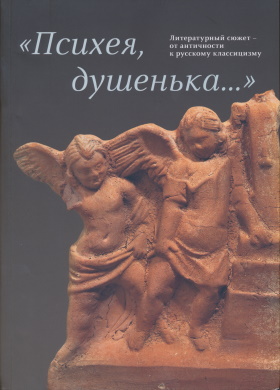 [ каталог выставки ]
[ каталог выставки ]
«Психея, душенька...»
Литературный сюжет — от античности к русскому классицизму.
/ Каталог выставки [29 января — 21 марта 2021 года.] СПб: Изд-во Гос. Эрмитажа. 2021. 244 с. ISBN 978-5-93572-915-8
[ аннотация: ]
Издание подготовлено к выставке «„Психея, душенька...” Литературный сюжет — от античности к русскому классицизму». Каталог включает в себя произведения античного, западноевропейского и русского изобразительного и декоративно-прикладного искусства. Сто двадцать экспонатов выставки объединены общей темой — воплощение мифологического и литературного образа Психеи на протяжении разных эпох. Каталог предназначен для специалистов и всех интересующихся литературой и искусством.
Содержание
Ю.Г. Семёнова. Бесконечные странствия Психеи. — 9
Каталог. — 49
Ю.Г. Семёнова. К некоторым особенностям образов Эрота и Психеи в античную эпоху. — 50
[Кат. 1-29. — 52]
Ю.Г. Семёнова. Образы Амура и Психеи на пересечении литературы и искусства Нового времени. — 98
[Кат. 30-47. — 100]
Ю.Г. Семёнова. «Душенька» как отражение идеалов русского классицизма. — 136
[Кат. 48-73. — 138]
Е.И. Арсентьева, С.В. Кокарева. Амур и Психея в античной и постклассической глиптике. — 194
[Кат. 74-120. — 200]
Принятые сокращения. — 234
Источники. — 234
Литература. — 234
Периодические и продолжающиеся издания. — 242
Прочие. — 242
[со стр. 4:]
Научный редактор Ю.Г. Семёнова.
Авторы вступительных статей: Е.И. Арсентьева, С.В. Кокарева, Ю.Г. Семёнова.
Авторы каталожных описаний: С.О. Андросов (С.А.), А.З. Антонова (А.А.), Е.И. Арсентьева (Е.А.), И.Р. Багдасарова (И.Б.), Ю.Б. Балаханова (Ю.Б.), О.Б. Баранова (О.Б.), А.Г. Букина (А.Г.Б.), А.М. Бутягин (А.Б.), А.В. Виленская (А.В.), Я.Э. Виленский (Я.В.), Е.В. Власова (Е.В.), О.В. Горская (О.Г.), Н.П. Гуляева (Н.Г.), Н.К. Жижина (Н.Ж.), Ю.И. Ильина (Ю.И.), Ю.О. Каган (Ю.О.К.), Ю.П. Калашник (Ю.К.), Е.И. Карчева (Е.К.), А.В. Катцова (А.К.), С.В. Кокарева (С.К.), О.Г. Костюк (О.К.), З.В. Купцова (З.К.), Д.Г. Лазаревская (Д.Л.), Л.В. Ляхова (Л.Л.), Ю.Г. Семёнова (Ю.С.), О.Ю. Соколова (О.С.), Н.И. Тарасова (Н.Т.), Э.А. Тарасова (Э.Т.), Е.Н. Ходза (Е.X.), Д.Е. Чистов (Д.Ч.), Ю.В. Шаровская (Ю.Ш.), Е.А. Шликевич (Е.Ш.).
Summary. ^
The exhibition of artworks from the collections of the State Hermitage Museum and the State Tretyakov Gallery is dedicated to the image of a particular character, Psyche, and its embodiment in art.
Image of Psyche as a winged human soul dates back to Ancient times. In the art of Antiquity she appears as a butterfly or a winged woman often paired with her beloved, Eros. Adventures of Psyche were first described by a Roman writer Apuleius in his novel ‘Metamorphoses’ (second century AD). However long time before that the relationships of the Greek god of love and the soul that fell under his spells was among the most frequent subjects in classical poetry. The image of Psyche was popular in the Renaissance and modern art. It developed based on literary sources – the novel by Apuleius and its numerous adaptations – and became widespread influenced by frescoes of the school of Raphael in the Loggia of Psyche, Villa Farnesina.
The exhibition includes 120 works of fine, decorative and applied art. The exhibition catalogue is divided into four sections: Antiquity, Western European and Russian art, as well as glyptics.
Terracottas and jewellery included in the first section demonstrate both the development of iconography and the functional purpose of objects bearing images of heroes. Lamps, mirrors and vessels illustrate the world of objects from the novel by Apuleius.
The section of Western European art opens with works in the tradition of the frescoes by the school of Raphael. The most celebrated incarnations of mythological heroes are present in sculpture and small-scale artworks such as Menacing Cupid and Psyche by Etienne Maurice Falconet, as well as Cupid and Psyche by Antonio Canova. Objects made of precious metals convey deep symbolic meaning to the images they show.
Section of Russian art is centred around illustrations by Fyodor Tolstoy to a poem by Ippolit Bogdanovich ‘Dushenka’ (Sweetheart), a free arrangement of Apuleius’ story taking place in Russia. The artworks displayed at the exhibition trace changes in the fairy tale’s interpretation over half a century which separates the creation of the literary text by Bogdanovich and illustrations that appeared at the period of Russian classicism.
Section of glyptics illustrates the most common scenes featuring Eros and Psyche on the carved stones dating back to Antiquity and modern times. Among them are the scenes depicting triumph of love and the torment of soul. Such images give an insight into the paintings and sculptures that have not survived to the present day. Western European carved stones reproduce famous Ancient Greek and Ancient Roman prototypes or depict original compositions created under the influence of painting and plastic art. The works of Russian masters, like the ‘Sweetheart’ by Ippolit Bogdanovich, while maintaining attachments to Greek and European sources, reveal the charm of the ‘Russian antiquity’.
|